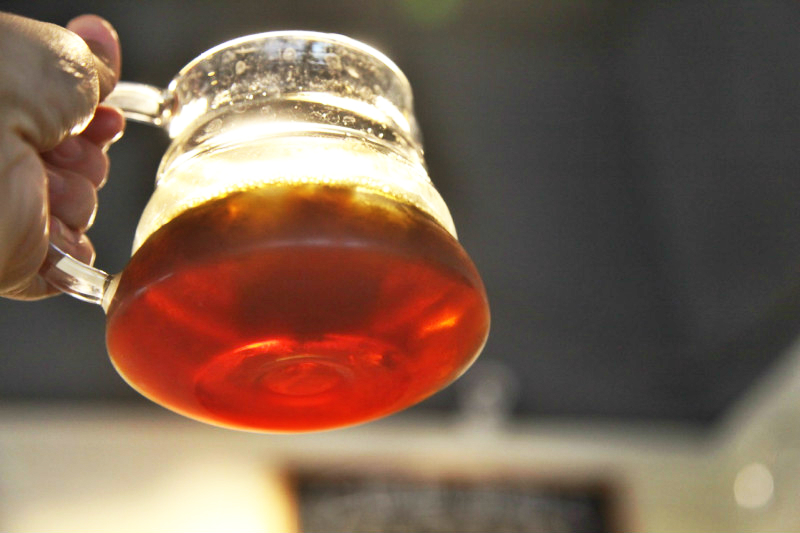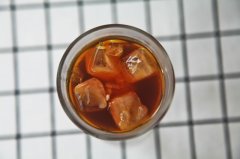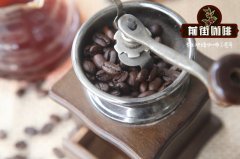What does the third wave of coffee represent? Why can Americans lead three waves of coffee?

Professional coffee knowledge exchange more coffee bean information please follow the coffee workshop (Wechat official account cafe_style)
The three waves of Coffee Revolution
The first wave: instant coffee (Instant Coffee) (note: Instant means "instant")
History of development
David Strang, a New Zealander, invented instant coffee in 1889 and made it in 1890.
Got a patent. Unfortunately, instant coffee invented by David Strang has not been commercialized.
It was not until 1901 that instant coffee was seen again. Kato Satori, one in
A Japanese scientist working in Chicago, USA, improved David Strang's instant coffee to make
Coffee powder dissolves more quickly, and Kato Coffee Company Kato Coffee is founded.
This is the first attempt to commercialize instant coffee, but Kato's instant coffee is also available.
It is not popular with consumers.
It was not until 1909 that George Washington, who lived in the central United States, began to sell.
With the idea of dissolving coffee, he began to sell his own coffee powder, which was founded in 1910.
The Washington Coffee Company Washington Coffee Company began mechanized mass production.
Canned instant coffee powder. Because of good marketing and advertising, Washington instant coffee is on the market.
Achieved initial success.
The instant coffee business in Washington reached its peak with the advent of World War I. At 1917
After the US military entered the war in #, the Washington Coffee Company became a munitions supplier to the US military, instant coffee.
It became an important material to support the allies in trench warfare, which became more popular against instant coffee after the war.
All right, the base also started the first wave of coffee dominated by instant coffee.
Nestle instant coffee
The world-famous Nestle instant coffee can be said to be the most important promoter of the first wave of coffee.
one. Nestle officially launched Nestle instant coffee in 1938 and in the 1940s and 1950s
Popular all over the United States, and then with the pace of globalization, Nestl é instant coffee appeared all over the world
Supermarkets, volume stores.
Until the rise of the second and third waves of coffee, that is, melted coffee was constantly criticized, and
We are losing ground in sales. Today, however, instant coffee is still commonly found in Chase.
Lu, however, the appearance of earbags seems to have dealt another fatal blow to instant coffee, namely soluble coffee.
It is no longer as prosperous as it used to be.
The first wave of coffee also seems to be the afterglow of the past.
Second wave: Express and Chain. (note: Expresso, espresso
(which means fast coffee)
History of development
In 1946, the Italian Gaggia improved the Italian coffee machine to make the coffee come out faster.
Faster and more efficient, which lays the foundation for the prosperity of the coffee chain, because the speed of the cup is determined.
The benefits of business. This Italian coffee machine was introduced to the United States by Italian immigrants, one of whom
Italian-American Lino Meiorin, Mediterranean Coffee in Berkeley, California in 1950
The library invented the most popular coffee flavor in modern times-latte. (the latte here is in a narrow sense.
A latte with milk foam. If only the drinking way of adding milk to coffee, as early as the 17th century
It was invented by the Venetians in the 19th century.
Starbucks represents this revolution. It went public in 1992 and opened in Japan in 1996.
It opened its first overseas store, and in the next decade, Starbucks became even more rampant
Step, the rapid expansion of the world, Japan, China, Taiwan, India, Indonesia and even Europe,
Starbucks can be found in South America, Africa and Oceania. Today, Starbucks
There are 21000 stores worldwide, of which 12000 are located in the United States.
Starbucks did create the second wave of coffee. If it were not for Starbucks, coffee culture would not be complete.
The ball is as widely spread as it is today, from street corners in New York, to businesses in Taipei, to
Cafes can be seen everywhere on the streets of Seoul.
However, blindly pay attention to fast, cheap waiters, business costs, and so on, and gradually put its coffee products
After the quality, finally let some people of insight reflect, is the coffee we want really like this?
The coffee shop chain represented by Starbucks has led the second wave of coffee.
The disease has in turn contributed to the rise of the third wave of coffee.
The third Coffee Wave (Specialty Coffee)
History of development
It was first started by Ms. Erna Nusen (Erna Knustsen), who is known as the "godmother of boutique coffee" in 1974.
In 2008, it was first proposed in the monthly Journal of Tea and Coffee (Tea& Coffee Trade Journal) to highlight "only"
Only in the most favorable microclimate and soil and water can we cultivate high-quality coffee with unique flavor.
It is different from the bulk commercial coffee on the New York Futures Exchange.
Knutsen's Erna Knutsen Coffee Co., Ltd. was held in Montreal, France in 1978.
In a speech, the representative of an international coffee conference said that the concept is simple: special geography.
Microclimate produces beans with unique flavor characteristics, which she calls "fine coffee (Specialty)."
Coffee) ".
This is a reflection on consumers' demand for coffee after the first and second waves of the coffee revolution: coffee.
The provider, blindly pursuing speed, quantification and cost, at the expense of the quality of coffee, consumers
It's not supposed to be like this!
1982 American Fine Coffee Association (Specialty Coffee Association of America
SCAA) is established.
Then, all over the world, gradually promoted and set up regional boutique coffee associations, such as European boutique coffee.
Coffee Association SCAE (1988), Japanese Fine Coffee Association SCAJ (2003).
Boutique coffee is defined in SCAA as "growing in an ideal climate and soil environment.
Special aroma and flavor of coffee. From the above definition, it can be found that fine coffee focuses on "raw".
The part of "beans", so raw coffee beans must have appropriate climate and soil environment in the process of growing.
And in the picking process and post-processing must also be strictly controlled, so that raw beans retain the characteristic flavor of the producing area.
With the taste, this kind of coffee can be called fine coffee.
Define
From the earliest concept of "special geographical microclimate to produce beans with unique flavor characteristics", the United States
The National Fine Coffee Association SCAA redefines "boutique coffee (Specialty)."
Coffee) ":
Boutique coffee is completed by the so-called lifelong pursuit of quality, from the beginning.
In the end, these people maintain a consistent standard of excellence to ensure quality and make it a priority.
Goal, and all the participants can work together, they are indispensable! They include "coffee."
Farmers (FARMER), raw bean buyers (GREEN COFFEE BUYER), baked beans
"COFFEE ROASTER", "BARISTA" (BARISTA needs to be able to brew
To be able to analyze the characteristics of coffee), "CONSUMER", from production to consumption
In the whole cycle, only when we cooperate to pursue the goal of excellence and quality, can we find a way to achieve high-quality coffee.
The true meaning of coffee.
What's interesting is that these three waves of coffee revolution in brewing coffee, from "instant" to "fast", the most
You need to slow down later. From the past, it emphasizes efficiency and provides the so-called added value (leisure space).
And back to the coffee itself. From the standpoint of consumers, from the need for knowledge to the need for knowledge, from nothing
From the choice to accept the products and culture offered by the overlord of the enterprise, to the coffee culture that you can choose and
The coffee supplier is required to provide the desired product.
The great wheel of the times has been rolling forward, the culture of coffee, the concept has also changed, whether we
Is it still in the era before the reform?
Important Notice :
前街咖啡 FrontStreet Coffee has moved to new addredd:
FrontStreet Coffee Address: 315,Donghua East Road,GuangZhou
Tel:020 38364473
- Prev

How to make cold coffee? how to make cold coffee without a refrigerator? how long can cold coffee be kept at room temperature?
Professional coffee knowledge exchange more information about coffee beans Please follow the coffee workshop (Wechat official account cafe_style) sounds very old-fashioned, but this summer is really hot! There are many ways to fight against the hot summer. In the coffee industry, the best solution, of course, is the cold-soaked coffee Cold Brew, which is so red and purple in recent years. With the popularity of cold-soaked coffee, coffee has become popular in the streets recently.
- Next

How many producing areas are there in Guatemala? What kind of varieties are mainly planted? Guatemala anchovies Manor Day
Professional coffee knowledge exchange more coffee bean information please follow the coffee workshop (Wechat official account cafe_style) how many producing areas are there in Guatemala? What kind of varieties are mainly planted? What are the flavor and taste characteristics of solarization in Guatemala anchovies manor? Specification: SHB EP products: bourbon, Kaddura production area: new Oriental production area Haiba: 1300 1700 m harvest time:
Related
- Detailed explanation of Jadeite planting Land in Panamanian Jadeite Manor introduction to the grading system of Jadeite competitive bidding, Red bid, Green bid and Rose Summer
- Story of Coffee planting in Brenka region of Costa Rica Stonehenge Manor anaerobic heavy honey treatment of flavor mouth
- What's on the barrel of Blue Mountain Coffee beans?
- Can American coffee also pull flowers? How to use hot American style to pull out a good-looking pattern?
- Can you make a cold extract with coffee beans? What is the right proportion for cold-extracted coffee formula?
- Indonesian PWN Gold Mandrine Coffee Origin Features Flavor How to Chong? Mandolin coffee is American.
- A brief introduction to the flavor characteristics of Brazilian yellow bourbon coffee beans
- What is the effect of different water quality on the flavor of cold-extracted coffee? What kind of water is best for brewing coffee?
- Why do you think of Rose Summer whenever you mention Panamanian coffee?
- Introduction to the characteristics of authentic blue mountain coffee bean producing areas? What is the CIB Coffee Authority in Jamaica?

